List of Malaysian coats of arms
This is a list of Malaysian coats of arms. Each of the thirteen States of Malaysia has their own coat of arms. In Malay, the coat of arms is called a jata.
National
| Arms | Date of adoption | Use | Description |
|---|---|---|---|
 | Used from 1988 after several modification in 1963, 1965, 1982 and 1988 | National coat of arms of Malaysia (Jata Negara) | Crest: Yellow crescent and yellow 14-pointed "federal star".
Shield: Equal divisions of four topped by single row of five krises, sided by a Pinang palm along with the Penang Bridge to the left and a Malacca tree to the right, and based on divisions containing the state arms of Sabah and Sarawak and a hibiscus. Supporters: Two rampant tigers. Motto: Bersekutu Bertambah Mutu (Unity is Strength) in Roman and Jawi. |
.svg.png) | 1963 | National coat of arms from 1963 to 1965 | The Federation of Malaysia arms in use between 1963 and 1965, with three new member states added to the bottom: Sabah, Singapore and Sarawak. |
States
| Arms | Date of adoption | Use | Description/Blazon |
|---|---|---|---|
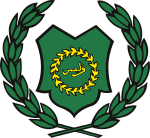 | 19-- | Coat of arms of Perlis | A green shield containing a yellow rice wreath and "Perlis" written in Jawi, enveloped by a wreath of two green rice stalks. |
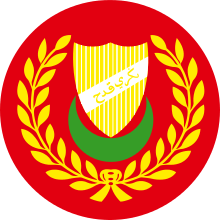 | 19-- | Coat of arms of Kedah | A yellow shield containing "Negeri Kedah" written in Jawi, with a green crescent below, both enveloped by a wreath of two yellow rice stalks. |
 | 1949 | Coat of arms of Penang | Shield: Barry wavy of ten Azure and Argent upon a chief Or a depiction of the Penang Bridge Proper
Crest: On a wreath of the Colours upon a mount a Pinang or Areca-nut palm leaved and fructed Proper |
 | 19-- | Coat of arms of Perak | |
 | 1916 | Coat of arms of Kelantan | A star and crescent backed by pairs of spears, krises and cannons, all of which are topped by a coronet, supported by a pair of muntjacs and carries a scroll containing "Berserah Kepada Tuhan Kerajaan Kelantan" written in Jawi. |
 | 1932 | Coat of arms of Terengganu | A dotted seal containing a coronet, a sword, a long kris, two books and a scarf, with "Terengganu" written in Jawi at the bottom and topped by a star and crescent, all enveloped by an oval outline. |
 | 19-- | Coat of arms of Pahang | A spear head sided by two halves of text written in Jawi, backed by a pair of tusks and based on a scroll containing "Negeri Pahang" written in both Rumi and Jawi. |
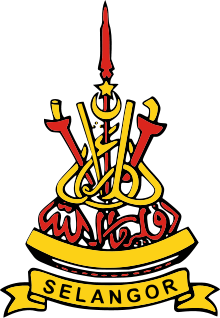 | 19-- | Coat of arms of Selangor | |
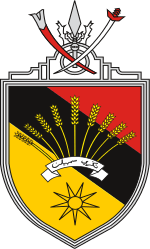 | 19-- | Coat of arms of Negeri Sembilan | A shield topped by a staff fronted by a red sword and red scabbard; the shield contains three diagonal bands of yellow, black and red, a scroll containing "Negeri Sembilan" written in Jawi that holds nine stalks of rice, and a nine-pointed star below. |
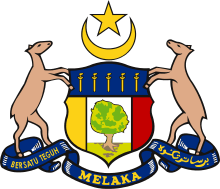 | 1963 | Coat of arms of Malacca | A shield containing five krises, two bands of red and yellow, and a Malaccan tree, all of which are topped by a star and crescent, supported by two chevrotrains (mousedeers), and based on a scroll containing "Bersatu Teguh" written in both Rumi and Jawi, and "Melaka" in Rumi. |
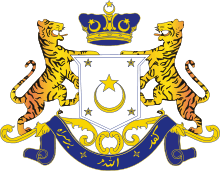 | 1860 | Coat of arms of Johor | A shield containing a star and crescent and four stars, topped by a coronet, supported by two tigers and based on a compartment and scroll containing "Kepada Allah Berserah" written in Jawi. |
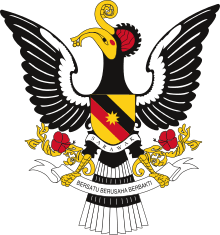 | 1988-present | Coats of arms of Sarawak | A shield features a symbolic wing-spread Kenyalang or Rhinoceros Hornbill with the shield bearing the state flag on its chest.[1] The hornbill's wings have 13 feathers, which represent the states in Malaysia.[1] The Hibiscus represent the Malaysia's national flower which appears on the right and left sides of the bird's legs and the hornbill is perched on a banner bearing the words "Bersatu, Berusaha, Berbakti" (Unity, Effort, Service).[1] |
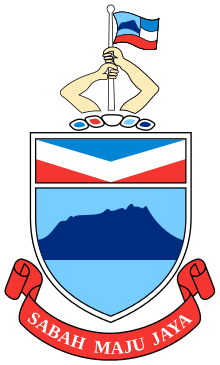 | 1988-present | Coat of arms of Sabah | The two arms carrying the Sabah flag represents unity and harmony among its multiracial citizens, while the silhouette of Mount Kinabalu in the shield represents the state of Sabah. The state motto, "Sabah Maju Jaya", is displayed at the bottom of the emblem. The five colours represent the five residencies of the state, as well as symbolising courage and determination (Red), purity and justice (White), peace and calm (Zircon blue), unity and prosperity (Icicle blue) and strength and harmony (Royal blue). |
Historical
| Arms | Date of adoption | Use | Description |
|---|---|---|---|
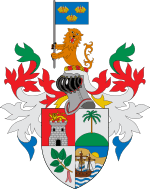 | 1874—1946 | Coat of arms of the Straits Settlements | |
.svg.png) | 1896—1948 | Coat of arms of the Federated Malay States | Quarterly "party per cross" shield containing four segments coloured white, red, black and yellow, topped by a coronet, supported by two tigers and based on a scroll containing "Dipelihara Allah" written in Jawi. |
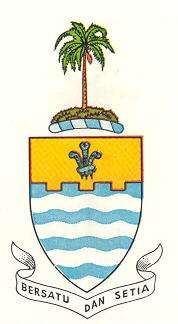 | 1950s—1980s | Coat of arms of the state of Penang from 1950s to 1980s. | The centre of the emblem has Prince of Wales's feathers before it was replace by Penang Bridge Proper during the construction of the bridge during 1980s. |
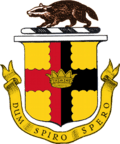 | 1841—1963 | Coat of arms of the Kingdom of Sarawak | The coat of arms has been used until 16 September 1963 when it joined Malaya, Singapore and Sabah (North Borneo) to form Malaysia. |
 | 1882—1963 | Badge of British North Borneo | The badge has been used until 31 August 1963, when British North Borneo became independent from Britain as "Sabah". |
.svg.png) | 1963—1982 | Coat of arms of the state of Sabah from 1963 to 1982. | |
.svg.png) | 1982—1988 | Coat of arms of the state of Sabah from 1982 to 1988. | During this period, the Sabah state government choose to adopt a state coat of arms that resembled Sarawak's hornbill, as a memory of the two Borneo states' common history as vassal states of Brunei in the pre-British times. Sabah adopted a kingfisher because its indigenous Bajau sea gypsies, who are politically powerful in the state administration, and another powerful indigenous group, the Bruneians from Brunei, identify with the bird to a great extent. Both Bajaus and Bruneians were traditionally fishermen, and amongst Borneo natives, birds are considered messengers of the gods. The omen bird for the fishermen is the kingfisher. The majority native tribe, the interior-dwelling Kadazans or Dusuns, identify with the kingfisher to a lesser extent, as the bird is commonly found amongst their main occupational group, the rice farmers. |
References and notes
- 1 2 3 "The State Crest of Sarawak". Sarawak State Government. Retrieved 23 November 2013.
See also
This article is issued from Wikipedia - version of the 8/5/2016. The text is available under the Creative Commons Attribution/Share Alike but additional terms may apply for the media files.